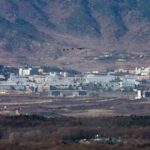
China is rapidly increasing its military capabilities aimed at the United States. Recently, it drew global attention by conducting an unusual test launch of an intercontinental ballistic missile (ICBM) into the Pacific Ocean. According to a report by China’s state-run Xinhua News Agency on September 25, the People’s Liberation Army Rocket Force successfully launched an ICBM into the Pacific. At 8:44 AM that day, the Rocket Force fired one ICBM equipped with a training dummy warhead, which landed accurately in a designated area.
The report stated that the ICBM launch was part of the Rocket Force’s annual military training schedule, effectively testing the performance of weapons and equipment to achieve its intended goals. However, it did not disclose the missile’s specifications, flight trajectory, or specific landing points.
The Chinese Ministry of Defense announced that it had notified relevant countries about the test launch, stating that it adhered to international law and customs and was not aimed at any specific country or target.
Given that China has typically conducted long-range missile tests in remote areas like Inner Mongolia without prior notice, this announcement has drawn unusual attention.
Analysts Speculate on China’s Deterrence Capabilities
Defense experts speculate that the missile tested was likely the Dongfeng-31AG or DF-41, capable of reaching the U.S. mainland. Some analysts view this test as a demonstration of China’s growing nuclear deterrence against the United States. China has also maintained a strong stance in the South China Sea, heightening tensions with countries like the Philippines and Vietnam while asserting its military power against U.S. influence in the Asia-Pacific.

U.S. Moves to Establish a Missile Defense Network
In response to China’s escalated missile capabilities, the United States has been constructing a missile defense network throughout the Asia-Pacific region, deploying ground-based intermediate-range missiles. This is part of a broader strategy to encircle China and deter potential military provocations, including a possible invasion of Taiwan.
On April 6, Charles Flynn, commander of U.S. Army Pacific, revealed during a joint press conference with Korean media that the U.S. plans to deploy intermediate-range missiles in the Asia-Pacific. “I won’t specify when or where they’ll be deployed,” Flynn remarked, reflecting the U.S.’s strategic ambiguity.
Typhon Missile System Deployed in the Philippines
Based at Joint Base Lewis-McChord, the 1st Multi-Domain Task Force (1st MDTF) temporarily deployed the Typhon launch system to northern Luzon in the Philippines. Although framed as a training deployment, the absence of a timeline for withdrawal has fueled speculation about a more permanent U.S. presence aimed at countering China.
The Typhon system, which can launch cruise missiles and SM-6 interceptors, significantly boosts U.S. capabilities. With hypersonic missiles capable of reaching speeds over five times the speed of sound, Typhon poses a formidable challenge to Chinese defenses.
A fully equipped Typhon launch system battery comprises an operational center, four launchers, and transport vehicles.
Following reports of the Typhon deployment, a Chinese military blogger on Sohu.com claimed that 70% of Chinese naval vessels and 50% of air force bases are now within Typhon’s range. China’s concerns highlight the system’s strategic reach and its implications for regional security.

First Deployment Since INF Treaty Withdrawal
This deployment marks the U.S.’s first overseas positioning of intermediate-range missiles since its 2019 withdrawal from the Intermediate-Range Nuclear Forces (INF) Treaty. The deployment is widely interpreted as a countermeasure to China’s growing missile capabilities. According to The Asahi Shimbun, the U.S. Army’s planned purchase of 330 Tomahawk Block 5 missiles over five years indicates that intermediate-range missiles in the Asia-Pacific region will likely increase.
The U.S. appears to be forming a First Island Chain missile barrier, deploying units sequentially in Guam, Japan’s archipelago, the Nansei Islands, and the Philippines to restrict China’s access in the western Pacific.
With Typhon positioned in northern Luzon, the U.S. gains a critical advantage. Luzon’s proximity—just 600 km from the Taiwan Strait—allows for direct targeting of Chinese assets. From this location, U.S. missiles can reach the Chinese Eastern Theater Command, key naval and air bases, and other strategic sites along China’s southeastern coast, providing a valuable tactical position.

China’s Response: A New Dynamic in the Asia-Pacific Standoff
For years, the Asia-Pacific region has been defined by a standoff between U.S. Navy carrier strike groups and China’s expanding missile forces. Historically, the U.S. has relied on carrier groups to assert its presence, while China focused on developing medium- and short-range missiles to deter these naval assets. China’s arsenal now includes the DF-21, nicknamed the “carrier killer,” and the DF-26 anti-ship ballistic missile. In 2019, China unveiled the DF-17, featuring hypersonic glide vehicles.
China’s naval ambitions have also accelerated. It recently launched its third aircraft carrier, Fujian, and is expanding its fleet of large destroyers. Analysts suggest China may surpass the U.S. regarding vessel count, underscoring the need for land-based U.S. missile installations.
Plans to Expand Typhon Presence in Japan
The U.S. is now moving to deploy additional Typhon systems in Japan. On September 4, Army Secretary Christine Wormuth disclosed that during an August defense forum, she discussed MDTF deployment with Japan’s Defense Minister Hamada Minoru. Despite Beijing’s disapproval, this move signals a strengthened U.S. commitment to the region.
China on the Defensive: A Reversal of Roles
China, which has previously threatened the U.S. with intermediate-range missiles like the DF-17 and DF-26, is not facing counterpressure. Recent reports suggest the U.S. is preparing to deploy intermediate-range missiles on Ishigaki Island, southwest of Okinawa. This base would join three others in Amami Oshima, Okinawa, and Miyakojima in Japan’s Nansei Islands if established.
In response to these moves, a Chinese official voiced alarm, stating, “This places Shanghai within a five-minute strike range. Are you aiming to provoke a second Cuban Missile Crisis?” China’s concerns underscore the shifting dynamics in the Asia-Pacific as it grapples with a more assertive U.S. missile strategy positioned close to its borders.















Most Commented